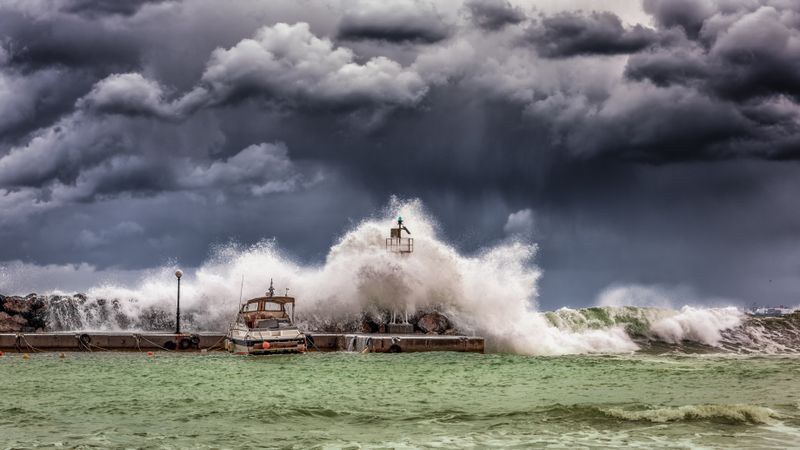Exploring the Depths: How Deep is the Titanic Wreckage in the Ocean?
A Perilous Search for the Missing Titanic Sub
The search for a missing 22-foot OceanGate submersible near the wreckage of the Titanic in the North Atlantic has captivated the world’s attention. With five people aboard, including crew members set out to explore the famous shipwreck, concern is mounting as oxygen to support life is expected to run out on Thursday. The Titanic, which currently rests about 13,000 feet under the sea, poses immense challenges for locating the lost submersible and its crew in the vast expanse of the North Atlantic.
The Depth of the Titanic Wreckage in Perspective
To truly grasp the depth of the Titanic wreckage, it is essential to compare it to other known depths in the ocean. For instance, sharks predominantly inhabit the surface layer of the ocean, extending only about 650 feet below sea level. This layer receives the most sunlight, making it an ideal habitat for photosynthetic organisms and various sea creatures.
Delving deeper, the ocean turns darker, and it is in these layers that nuclear submarines can plunge. According to the Woods Hole Oceanographic Institution, these submarines are capable of diving as deep as approximately 984 feet. Going even further, the deepest rescue underwater recorded is a submersible named Pisces III, which sank to 1,575 feet below sea level southeast of Ireland in 1973.
However, none of these depths compare to the monumental depth of the Titanic wreckage. Resting approximately 2.5 miles beneath the ocean’s surface, which translates to around 13,000 feet, the haunting remnants of the ill-fated vessel reaffirm the magnitude of the disaster that occurred over a century ago.
Deeper Depths: From Shipwrecks to the Unexplored Mariana Trench
While the Titanic remains one of the most famous shipwrecks, the ocean holds even deeper secrets. One such example is the U.S.S. Samuel B. Roberts, which sank off the Philippine coast in 1944, plummeting to an astonishing depth of about 22,621 feet—well below the Titanic‘s resting place. This shipwreck serves as a somber reminder of the sacrifices made during wartime.
Beyond shipwrecks, humans have ventured into the abyssal depths of the ocean. The Mariana Trench, situated east of the Philippines, holds the distinction of being the deepest known point on the planet. Renowned filmmaker James Cameron successfully explored this undersea chasm in his submersible, the Deepsea Challenger, reaching a staggering depth of 35,456 feet, equivalent to roughly 6.7 miles. This extraordinary feat exemplifies the indomitable spirit of human exploration.
The Implications of Deep-Sea Exploration
The ambition to explore the depths of the ocean has always intrigued humanity. Through advancements in technology, including submersibles and remotely operated vehicles (ROVs), we have been able to gain invaluable insights into the mysteries of the undersea world. Whether it is uncovering historical artifacts, studying marine life, or delving into geological phenomena, deep-sea exploration has expanded our knowledge and reshaped our understanding of our planet.
However, deep-sea exploration also raises important ethical considerations. As we push the boundaries of our understanding, we must balance our inherent curiosity with a deep respect for the fragility and interconnectedness of our ecosystems. It is imperative to ensure that exploration is conducted responsibly, minimizing any potential harm to delicate marine ecosystems and preserving the integrity of these underwater environments for future generations.
Editorial: Reflecting on the Titanic‘s Legacy
Over a century after the Titanic‘s tragic sinking, its story still resonates with people around the world. The shipwreck serves as a symbol of human ambition, hubris, and the unpredictable power of nature. It reminds us of the consequences that can arise from taking risks without careful consideration.
Yet, amidst the tragedy, the Titanic also serves as a poignant reminder of the resilience and compassion that emerged in the face of disaster. The stories of heroism and selflessness exhibited by individuals on that ill-fated night remain etched in our collective memory.
As we grapple with the ongoing search for the missing submersible near the Titanic wreckage, it is essential to remember the lessons this story imparts. Our human pursuit of knowledge and exploration should always be accompanied by a deep sense of responsibility, respect for the environment, and a commitment to prioritize safety and well-being.
Advice: Navigating the Depths of Curiosity
The human spirit thrives on curiosity, propelling us to venture into uncharted territories and discover the unknown. However, when embarking on quests for knowledge and exploration, it is crucial to do so with careful consideration and preparation.
For deep-sea exploration, it is essential to prioritize the safety and well-being of all involved. Rigorous training, thorough risk assessment, and adequate emergency protocols are paramount. Additionally, ensuring that the latest technological advancements are utilized can enhance safety and efficiency in these endeavors.
Moreover, when exploring fragile and vulnerable ecosystems, it is our responsibility to prioritize conservation and protect these environments from harm. Marine life and delicate underwater habitats must be regarded with the utmost respect, allowing us to learn from them without causing irreparable damage.
In conclusion, the depths of the ocean continue to captivate our collective imagination. As we navigate the challenges posed by the search for the missing Titanic submersible, let us remember the lessons learned from the Titanic disaster: the importance of responsible exploration, the resilience of the human spirit, and the need to strike a delicate balance between curiosity and caution.

<< photo by Francesco Ungaro >>
The image is for illustrative purposes only and does not depict the actual situation.
You might want to read !
- “The Depths Unveiled: James Cameron’s Reflection on Deep-Sea Exploration”
- “Mysteries of the Depths: Unraveling the Enigma of the Missing Titanic Submersible”
- The Disappearing Depths: A Race against Time for the Missing Titanic Submarine
- Exploring the Depths: Unveiling the Mounting Pressures of the Ocean
- “Edgy Encounters: The Mysterious Disappearance of Explorer Hamish Harding and the Search for Answers”
- The Growing Need for Stringent Safety Measures on Cruise Ships
- Exploring the aftermath: Assessing the injuries and impact of a gas explosion in central Paris
- The Aftermath of the Paris Explosion: Examining the Impact and the Road to Recovery
- Exploring the Depths: The Search for the Sunken Titanic Tourist Submarine




